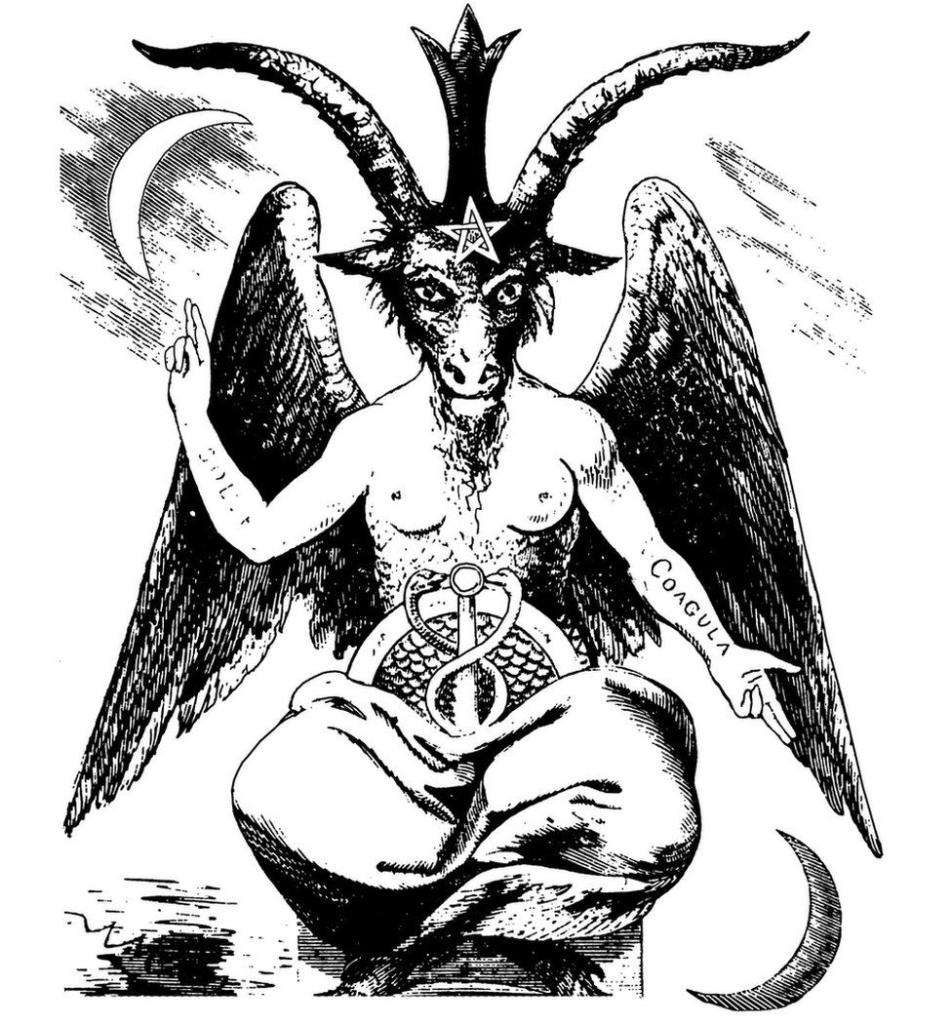
This is the 6th trump and is associated with the number 5. Traditionally this card is called the pope and sometimes the High Priestess Card is called the Papess (or female pope). I think I’ve seen one pack that even calls this the High priest, but that feels like some Wiccan stuff. Gébain changed the name of this card in an attempt to De-Christianify the pack. He chose the name of the chief priest of Eleusian mysteries, the hierophant instead of the Pope. The name Hierophant is Greek for revealer of the sacred/sainted. The Hierophant and High Priestess cards are closely related, but this card is also subtly related to the magician card.
Remember that at the time that the tarot appeared, the Pope would have control over several states in Italy so represented a strong political power as well as a religious leader.
Waite who commissioned the card is somewhat jaded with negative views about the character it features. He says quite clearly in his Key to the Tarot that he is NOT the “Prince of the Occult”. Instead, for Waite, he represents the Sum of all Theology in a state of extreme rigidity. Considering Waite was already pretty rigid then this is saying something. The hierophant might be a channel for grace, but Waite saw him as institutional rather than natural. He might be the highest authority in the church, but he is simply an earthly stand-in for divine authority and Waite suggests sometimes a pope might forget this and assume he is the authority. He is not philosophy other than theology and not inspiration (that’s the High Priestess), but instead the final expression of religion. Divine light bought forth, but now suffering from rigour mortis.
The Pillars
This is not the first card we have come across with two pillars. You will note that the High Priestess card features the pillars of Boaz and Jachin, but here we have two pillars that both are grey. The High Priestess is esoteric and features the divine’s relationship and messages for the individual through active action (Jachin) and passive reception of the individual (Boaz), but this card, on the other hand, is exoteric and features the divine’s relationship with a whole population through the priesthood. This relationship is through the priesthood as a medium, so there is less distinguishing between the pillars. When the priesthood stands in place of a direct relationship with the divine, we do not get close enough to the divine to tell the difference between different sides of the deity. Instead of the pillars that rest on either side of the Veil of Peroketh, these are the pillars at the front of the temple facing outward toward the people. The pillars do not represent active and passive as they mean on the High Priestess, on this card the pillars represent Freedom and Law, as they exist within a populace.
Crown and Cross
Both the Crown and the Cross feature the number 3. Ménange á trois anyone? The Crown has three layers and the cross has three Patibuli (the beam across a crucifix). It is believed that these resemble the 3 nails used in the crucifixion of Jesus Christ. One in each hand and one through both feet. (Although traditionally Roman crucifixion was done with 4 nails, it has become common to represent Christ nailed with 3 to depict the trinity). Going down the Hierophant’s placket (the joining part of a top where the buttons are) there are three buckles in the shape of crucifixes. In the top of the Crown, there are also 3 nails. They represent the three nails on the cross, but they also form a w which is the sound of the Hebrew letter Waw (sometimes vav) associated with this card. This letter means hook. Ironically it was the word used to refer to the hook that holds up the veil of Peroketh in the temple and the hooks used to carry the tabernacle with the ark of the covenant in it.
The 3 symbolise the spirit behind religion, that which the Hierophant conveys to the people. In the writings of Dion Fortune, she equates the Sephiroth on the Tree of the Life called Kether, Tiphereth and Yesod to the holy trinity. So this card represents that power brought to the people in Malkuth completing the middle pillar.
Sign of Benediction

The Hierophant holds his hand out as a sign of benediction blessing the people. If we look carefully at his hand we see that two fingers point up and two fingers point down. This is a smaller and more subtle expression of the sign we saw in the Magician card. One hand up and the other hand down. The esoteric is still present in the priesthood, but it is much more subtle. It is withheld for the priesthood and only partially shared with the populace. The hand gesture is identical to the right hand of Eliphas Levi’s Baphomet. The up and down reminds us also of the 9th-century text, the Emerald Tablet, “What is below is as what it is above”.
The Vestments and Throne
The robe and throne symbolise the power and authority of the religious establishment. When the pope was originally included in the Tarot deck the pope would have politically ruled over most of Italy as an elected official and had religious power over the rest of Italy. So this card is more about the religious authority as a society-moulding power, rather than for spiritual guidance, which the High Priestess represents. This card is outward-facing, whereas she is inward-facing.
The 3 crosses down the front of the Hierophant’s white placket further remind us of the trinity or the top three sephiroth of the middle pillar, which the Hierophant attempts to bring into society (Malkuth).
The shoes of the Hierophant bear the sign of the cross further symbolising the authority of the church.
Monks
In front of the Hierophant, kneel two “tonsured” monks. (Tonsured is the haircut where a shape is shaved into the top of the hair.) This tonsuring is a sign of their renunciation of the material things to serve the divine.
Roses and Lilies on the Monk’s Clothing
Weirdly Waite described the monks as wearing Albs (white robes) so it might be not this final version of the card that he was writing about. The outfits of the two are dressed in feature Roses and Lilies, which we previously saw mixed at the bottom of the Magician card. In the Hermetic Order of the Golden Dawn whenever the order ritually honours the deity of Malkuth (or physical reality), known as Adonai, they say “Yours is the Kingdom, the power and the Glory. The rose of Sharon and the Lily of the Valley”. This line reminds me of the Second Song of Solomon which begins with “I am a rose of Sharon, a lily of the valleys”.
I explored the meaning the Roses and Lilies on in the Tarot cards. Find the article here.
The Yellow Paliums on the Monk’s backs
I am told the yellow paliums (Y-shapes) on the backs of the monks symbolise Mercury and therefore their intellectual understanding of the divine that has been presented to them. I don’t know about this interpretation and there seems no mention in Waite’s notes. Certainly, the shape makes me think of a Y which would symbolise the first letter of the Tetragrammaton. I guess they represent YHVH’s staff on earth, but Y has very little to do with their position. They are almost entirely receptive to YHVH, whereas the Y symbolises the power of action of YHVH, not a role they fulfil in their obedient, subservient roles.
The Keys of St Peter
Below the feet of the Hierophant are the keys of Saint Peter. Obviously, these represent the keys to Heaven. They are a common motif on papal designs. They symbolise the keys that Christ promised to grant to St. Peter in the book of Matthew:
I will give you the keys of the kingdom of heaven, and whatever you bind on Earth shall be bound in heaven, and whatever you loose on Earth shall be loosed in heaven.
Matthew 16:19 – Accredited to Jesus Christ
Anyone who is awake will immediately note a similarity between this and the 9th-century Hermetic Text, the Emerald Tablet, which begins:
“As below so that it be above and as above so shall it be below.”
The Dias
The Hierophant is raised up by his authority and association with the divine by a dias. Like his robe, it is also red. This could be symbolic of the completion of alchemy or perhaps the active power of the divine that he commands on earth.
Two strips run passed him on each side. These are chequered black and white symbolizing Boaz and Jachin the black and white pillars that appeared on the High Priestess card. The esoteric is still present in this exoteric card, but once again we find it hidden and subtle.
I have come across people trying to interpret the “4 disks” which appear on the dias that the Pope sits on however it was someone telling me it symbolised 4 of Pentacles which they called “Taurus”, however when I attributed the decans to the pip cards, I found it to be associated with Capricorn which Crowley has had Lady Freida Harris draw on his version of the card. So I find that to be an unusual attribution. For me, the disks represent the element of earth and this card is associated with Taurus which is an earth-sign so perhaps there was more to this. I am not certain, but on close inspection, I believe a 5th disk is emerging from beneath the cloth on the left-hand side (the pope’s right) at the back. It is hard to tell, but this might actually be 5 of disks which is a Taurus sign and the number associated with this trump.
Interpretation
When interpreting this card I remember a story and see what parts of it are drawn more firmly into my mind.
There were once two lands each with a different rulership. One was a land of Law regulating everything, but pressing free will; the other, a land of freedom that lived in Chaos. Neither society was happy. In a bid for power, the Pope presided over the arranged marriage between the ruling families’ children. Once married a new society was formed, but both lands relied on the pope to tell them how to live. With his divine inspiration, he gave them rigid laws and religious leadership, however, he offered no power to the people to understand the law, they needed to follow the laws mindlessly. They had a better society, but they did not thrive because they never knew the divine where the new law came from and they were forever dependent on the establishment of the pope. One day the Pope grew weary and he knew his life was going to end, so he taught the secret of communication with the divine to two monks so they might hold the keys to the kingdom of god. One sought god through his teaching, but the other sought earthly power. His cardinals warned him not to give them equal share, but he was stubborn like a bull and he gave them equal part of the divine knowledge and required they work together to lead the people.

Comments
2 responses to “The Hierophant – Tarot”
[…] The Fool The Magician The High Priestess The Empress The Emperor The Hierophant […]
[…] which are seen on the World card of the tarot, Crowley’s Universe card and Crowley’s Hierophant card. The 4 beasts are also mentioned in the tau path in the Hermetic Order of the Golden Dawn. The Tau […]